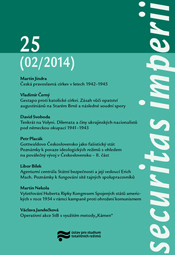Česká pravoslavná církev v letech 1942–1945
Czech orthodox Church in the years 1942–1945
Author(s): Martin JindraSubject(s): WW II and following years (1940 - 1949), Fascism, Nazism and WW II, Eastern Orthodoxy
Published by: Ústav pro studium totalitních režimů
Keywords: Czech orthodox Church; 1942-1945; operation Anthropoid;
Summary/Abstract: The study looks into the developments in the Czech Orthodox Church in the pivotal years 1942-1945 which were fundamentally affected by the realization of the military operation Anthropoid and the subsequent dissolution of the church. Readers are introduced to the story at the beginning of the year 1942 when a number of restrictive measures had been taken aimed at churches in the Protectorate Bohemia and Moravia. A decisive turning point for the Orthodox Church and its believers came after 27 May 1942. After the successful assassination of the Acting Reich-Protector Reinhard Heydrich, the “magnificent seven” Czechoslovak soldiers including Josef Gabčík and Jan Kubiš found shelter in the vaults of the Orthodox church of Ss. Cyril and Methodius. After they had been located, Prague priests and officials of the Orthodox Church were arrested. On 3 September 1942, a martial court sentenced chaplain Vladimír Petřek, chairman of the board of elders of the Prague church congregation Jan Sonnevend, pastor Alois Václav Čikl and bishop Gorazd to death. More orthodox families were arrested whose members would later meet their death in the underground bunker in Mathausen. On the eve of St. Wenceslas holiday on 27 September 1942, the daily press informed about Kurt Daluege’s order by which the Czech Orthodox Church was dissolved, all its activities banned and its property confiscated. The study describes the course of the liquidation of Orthodox Church congregations, arrests of clergymen and layman officials and their future destinies as forced labourers. It is innovative in that it studies in more details a part of the history of the Orthodox Church, which has been until now neglected by historiographers. The presented text is concluded by a chapter dedicated to the reconstruction of the Orthodox Church, which has been affected not only by an array of objective hardships (e.g. the absence of the bishop, lack of priests, damaged churches and church property) but also by the temporary revolutionary takeover of the administration of the Orthodox Church by a Prague assistant clergyman Alois Václav Červín and a desk officer at a Church department Vsevolod Kolomacký.
Journal: Securitas imperii
- Issue Year: 2014
- Issue No: 25
- Page Range: 10-39
- Page Count: 30
- Language: Czech

